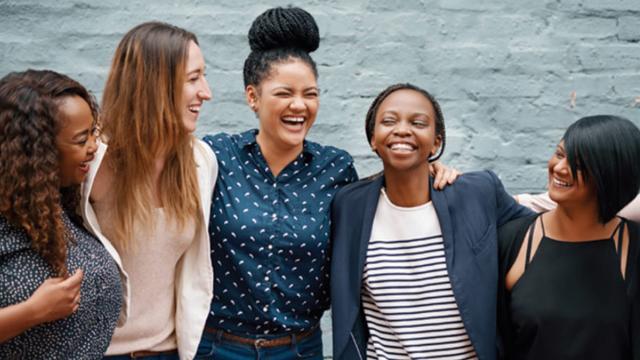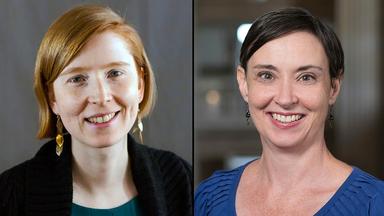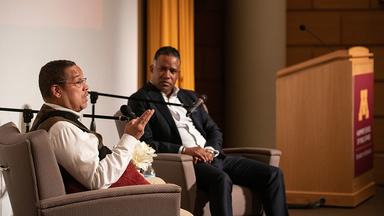For the past 10 years, the Humphrey School’s Center on Women, Gender, and Public Policy has partnered with the Women’s Foundation of Minnesota to produce the leading research on women and girls in the state.
The 2020 Status of Women and Girls in Minnesota report, released this week, shows progress in some areas since the last biannual report. But systemic gender and racial inequities continue to trap many women in poverty, compromise their safety, hinder access to healthcare, and limit leadership opportunities. Inequities for women and girls accumulate over a lifetime and are impacted substantially by race, place, LGBTQ+ status, and other identities pushed to the margins.
“Each Status of Women and Girls in Minnesota report disaggregates the statistics by race and ethnicity, including attention to Black communities, Native communities, and Minnesota’s largest immigrant groups,” said Professor Christina Ewig, who led the research team behind the report. “Understanding Minnesota’s community variation is key to crafting responses that address the unique disparities faced by different groups.”
The report focuses on four distinct issue areas, using a unique gender-race-place-equity lens.
Economics
Women’s areas of study and occupational fields, wage gaps experienced in the workforce, and lack of affordable, accessible childcare results in economic vulnerability over the course of a lifetime, which can lead to housing insecurity, debt, poverty, and reduced access to health care in old age.
Particular barriers for women of color and Native American women spotlight Minnesota’s significant racial inequities, including a substantial and growing wealth gap between white Minnesotans and everyone else. As COVID-19 continues to impact the economy, these disparities have become even more stark.
Safety
Women and girls in Minnesota are harmed by gender-based violence across their lifetimes – in their homes, on the streets, and in public institutions like schools, workplaces, and the criminal justice system. One in two Minnesota women report sexual violence, and one in four report physical violence from a partner in her lifetime.
The 2020 report particularly highlights health and safety disparities faced by Minnesota’s tribal communities. “In this year’s report, we uncovered disparities faced by Native women that we had not seen in previous reports,” said Ewig. Native American women face violence at alarming rates, with more than 85 percent experiencing violence and 56 percent experiencing sexual violence in their lifetimes – a 20 percent greater likelihood compared to white women.
Health
One in five Black women and one in four Latina women in Minnesota reported that they could not see a doctor because of costs in the past year. “Increased insurance coverage in Minnesota under the Affordable Care Act was a critically important step toward health equity,” noted Ewig. “Unfortunately, state data show a downturn in coverage rates in the past year.”
The report also shows disparities based upon place, including the high teen birth rates in rural Minnesota. Of all rural Minnesota counties, more than 47 percent have no sexual health clinic, while Hennepin County has 18 such clinics. “For expectant mothers in rural areas, care is becoming increasingly inaccessible,” said Ewig. In rural Minnesota, hospitals offering birthing services dropped by 38 percent.
Leadership
Although women’s representation among Minnesota’s corporate executives has risen in recent years, at the current rate it would take 52 years to reach gender parity. “We know from extensive scholarship that bringing women with diverse backgrounds and experiences into leadership positions brings clear benefits,” said Ewig. “Companies experience higher levels of innovation, while government becomes more representative.”
The November 2018 elections brought many firsts, especially for women of color and Native American women in Minnesota. While the number of women in the State Legislature has dropped, in 2019 the state swore in its most racially diverse Legislature to date, 50 percent of whom were women of color. However, men dominate county governments, and women mayors remain rare in Minnesota.
“Amid COVID-19 and the undeniable visibility of racial injustice, it’s never been more apparent that our state’s renowned prosperity and quality of life are not experienced by all Minnesotans,” said Gloria Perez, president and CEO of the Women’s Foundation of Minnesota.
“We know that Minnesota’s Black, Indigenous, and people of color experience a state that has some of the worst racial inequities in the nation. At the Women’s Foundation, we identify this report as a call for individuals and institutions to dismantle racial and gender inequities, increase investments in community solutions to end racial and gender injustice, and transform our state’s systems to create a Minnesota where all women and girls thrive.”


